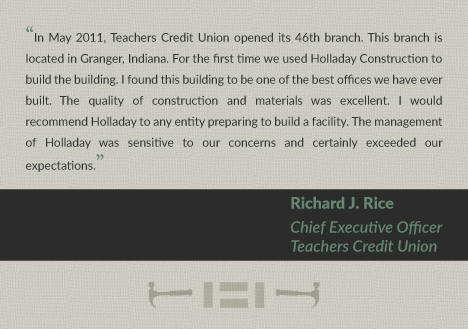Holladay Construction Group broke ground on a 4,100 square foot credit union building in September 2010 for Teachers Credit Union. The building’s shell is comprised of the used of a Porter SIP (structural insulated panel) system. SIPs are walls, roofs, floors and foundations made of panels consisting of a rigid foam insulation core sandwiched between two structural skins. The seamless, closed-cell rigid foam core helps reduce air leakage and thermal bridging through the panels by providing a continuous span of insulation.
Listed below are several major advantages to consider when choosing the SIP System.
- SIP buildings use approximately half the energy of conventional buildings.
- SIPs can be used for virtually any building design and are particularly useful when open designs with long roof spans are desired.
- SIPs can be erected in approximately half the time of a conventional building, according to a study by Reed Construction Data RSMeans Business Solutions, which showed that utilizing SIPs reduced installation time by 130 labor hours.
- SIPs are an engineered product that can be designed to meet the required loads but are also inherently much stronger that conventional framing.
- Owners of SIP buildings report less interior noise, fewer drafts, and more consistent interior temperatures due to the continuous foam core inside every SIP.
- Due to their inherent air-tightness, SIPs make control of indoor air quality possible since incoming air can be filtered and stale air can be expelled in a controlled manner.
- SIP buildings can be insured less expensively specifically in high wind areas due to their superior strength.
- Building with SIPs helps earn many tax credits and LEED points.
- SIPs can help reduce heating and cooling loads over the lifetime of a facility

